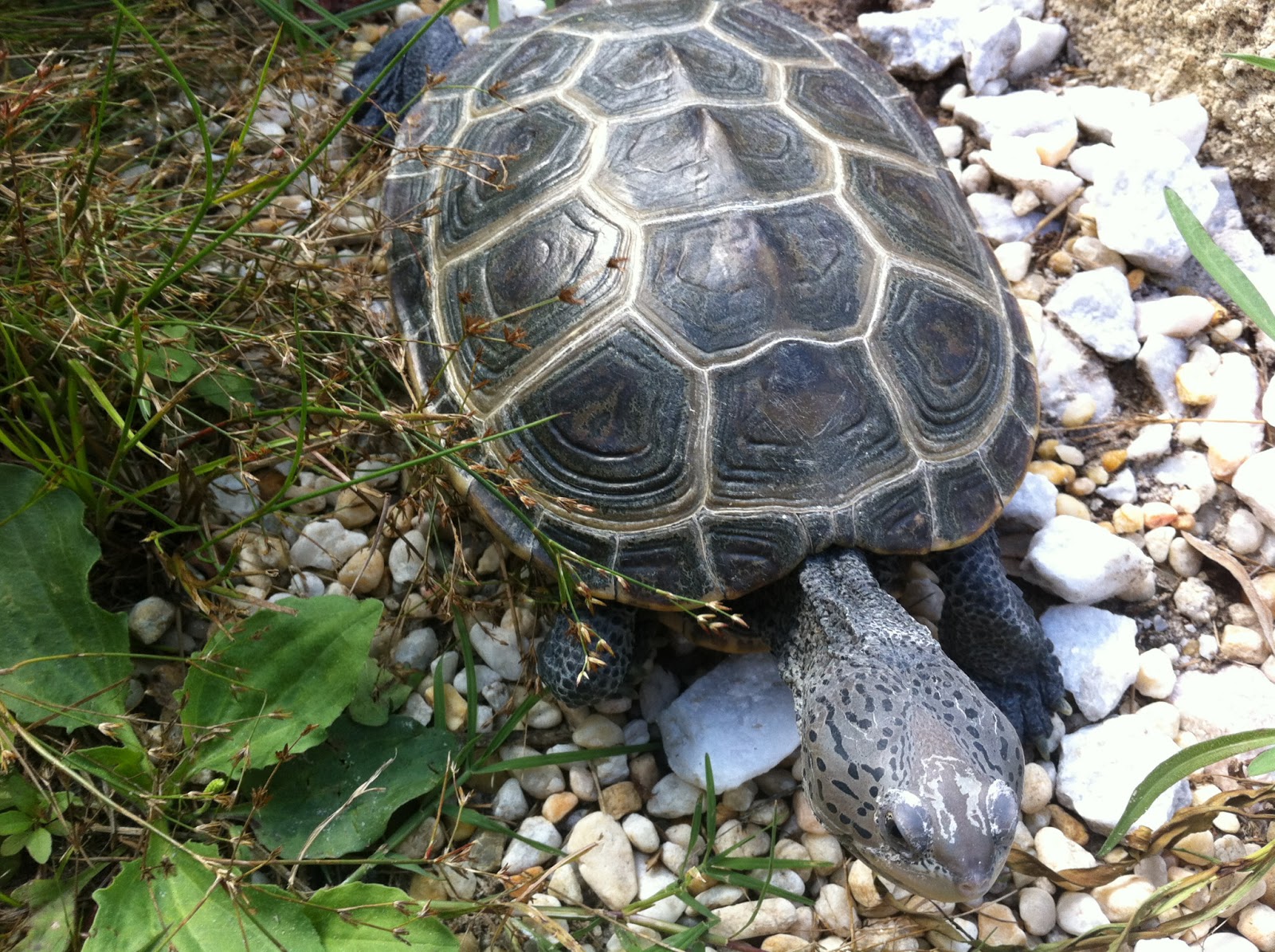Diamondback terrapins are a very special species of turtle. They are probably the only turtles which live exclusively in brackish water. There are found all along the east coast of the United States, especially along Georgia's coast. In addition to occupying a very specific niche, they are a very beautiful species of turtle. The color of their skin can range from powdery white to black, and all shade of blue in between. Frequently their skin is adorned with unique patterns which can be either speckled or linear. The shell on their backs, called a carapace is also often patterned. Terrapins from South Carolina are often distinguished by their red or amber belly shells.
The species is separated into a handful of subspecies. Members of the subspecies can interbreed, but their natural habitat ranges are so separated that this rarely happens in nature. The turtles are not federally protected, although they probably should be. In the state of Georgia, they are a protected species. Rhode Island denotes them as endangered, and Massachusetts considers them threatened. Perhaps Georgia, or the United States in general, should adopt more protective measures when it comes to the diamondback terrapins.
The species faced rapid decline during European colonization of the east coast. They were considered a delicacy and hunted all over their range for gourmet restaurants. Current threats to their populations are related to habitat destruction. I work with a student organization at Armstrong Atlantic State University called TERPS (Terrapin Educational Research Program of Savannah) which is concerned with their conservation. My good friend Andrew Neidlinger is currently running this organization and performing field research on the wild populations of terrapins near Savannah, Georgia.
While degradation of the marshes themselves is a major threat to the turtles, road construction is the most significant cause of their decline in Georgia. Highway 80 connects Savannah to Tybee Island. During the summer, this highway carries high volume traffic from Savannah to the beaches on Tybee. The speed limit on parts of the road is 55, but drivers often speed. Unfortunately, the peak season for tourism on Tybee coincides with the turtles nesting season. Females cross from the marsh on the northern side of the road to nest on the southern side. All too often, they are hit by cars.
The TERPS club has a hotline for drivers to report struck turtles. If we find a live turtle, we rehabilitate the animal in the lab before releasing him or her to a safer location. If we find a recent female victim of roadkill, we to see if she is gravid. Often we recover eggs which we can hatch in our lab. Last October, we hatched 3 baby terrapins in our lab. On June 13, 2013, Andrew and I took these 3 babies, as well as another wild born baby whom we recovered and nourished in the lab, to Fort Pulaski to release. Mary Landers, a reporter from Savannah Now, met us there to learn about our project and the threats to the turtles. Because the vast majority of baby turtles are eaten rapidly after they hatch, allowing them a 8 months of growth in the lab greatly increases their chance of survival in the wild.
Currently, there is talk of widening Highway 80 to accommodate more Tybee traffic. The TERPS organization has a suggestion, should this expansion occur. If the road is expanded, a tunnel should connect the marsh beneath it. This would give the terrapins a safe way to cross from one side of the marsh to the other to nest.
It is important for the public to know about these turtles and learn about conservation efforts. Their population has declined rapidly, and their nesting habits are being altered by human interference. If this species is to thrive, efforts must be made to protect them. Drivers should not speed on the stretch of Highway 80 that cuts through the marsh, or else they risk hitting pregnant females. If drivers do hit or see a hit turtle, they can contact the TERPS club to rehabilitate the animal or extract eggs. Also citizens should be aware that the species is protected, but current population estimates show such a rapid decline that they probably should be considered threatened or endangered. With this knowledge, the public can support legislature that demands more stringent protection for the turtles.
Here is the hotline number:
912.659.0978.
These are some photographs I took of the turtles at our facility at Armstrong. The first picture is of one of the babies that we released yesterday.
The next photo is of a juvenile female called Cleopatra. Her mother was a roadkill victim and we hatched Cleopatra in our lab. Her clutchmates were released back to the wild. Notice her striking pattern. The carapace is marked with concentric lines which can be used to estimate the turtles age. Each lighter band signifies a year of growth.
The last photo is of a female called Satilla. She was injured and thrives in captivity. However, her injury would put her at a disadvantage in the wild, so we chose to keep her in our captive breeding program. She is currently pregnant and we are hoping to hatch her eggs in the lab!! Notice that her pattern is more speckled and less linear than Cleopatra's.
Thanks for reading about the terrapins, and please support protection for this species by not speeding on Highway 80, calling in hurt animals, and supporting protective legislation!
Keep an eye out in the Savannah Morning News for Mary Landers's article about the turtles. You'll see some great photos of the turtles and hear Andrew's expert opinion on their conservation. You might even see a cameo by me in the article!



No comments:
Post a Comment